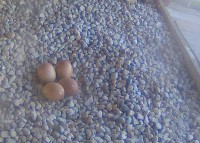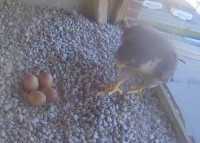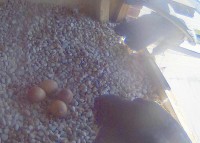Lawrence Peregrines: shell breaking process!
May 11, 2018 in In the Nest Box, lawrence peregrines, Peregrine Falcons Eastern Massachusetts, Peregrine Falcons Massachusetts
 As we approach the hatching of the first egg, the peregrines start the day under clear skies and bright sun, winds from the west at 8 MPH, and the temp at 62F at 6 AM. After a week filled with foggy mornings and cooler coasts, a cold front overnight is changing the pattern for the end of the week. A few clouds may linger this morning, but the shower chances will be long gone as the cold front will have already cleared the region. It will be a breezy start to our morning, but the wind shift is key. The wind direction will be out of the northwest and typically would usher in “colder” conditions. Farther inland where the seabreeze doesn’t impact the daytime heating, it will feel slightly cooler compared to the last few days.
As we approach the hatching of the first egg, the peregrines start the day under clear skies and bright sun, winds from the west at 8 MPH, and the temp at 62F at 6 AM. After a week filled with foggy mornings and cooler coasts, a cold front overnight is changing the pattern for the end of the week. A few clouds may linger this morning, but the shower chances will be long gone as the cold front will have already cleared the region. It will be a breezy start to our morning, but the wind shift is key. The wind direction will be out of the northwest and typically would usher in “colder” conditions. Farther inland where the seabreeze doesn’t impact the daytime heating, it will feel slightly cooler compared to the last few days.
 Around 5:55 AM, the male was incubating the eggs, and departed the nest box. About 5 minutes later, the female arrived at the nest box, and quickly settled in on the 4 eggs. We continue to keep watch for the first hatch!
Around 5:55 AM, the male was incubating the eggs, and departed the nest box. About 5 minutes later, the female arrived at the nest box, and quickly settled in on the 4 eggs. We continue to keep watch for the first hatch!
Shell-Breaking And Emergence
Often chick creates an opening in break-up area around pip before final breaking open of shell begins; then, looked at from blunt end of egg, chick makes a counterclockwise turn inside shell, at same time breaking a line around circumference of egg near blunt end by thrusting egg tooth against shell. Chick turns intermittently, breaking a portion of shell with much vocalization, then rests, and turns again. This last stage of hatching takes 15–60 min. Artificially incubated eggs hatch most frequently during morning hours: 40% of 500 eggs found hatched between 06:00 and 12:00; 24% between 12:00 and 18:00; 19% between 18:00 and 24:00; 17% between 24:00 and 06:00.
 Just after 1:30 PM, the peregrines had a changing of the guard and switched places for incubating duties. Back to the hatching discussion….eggs generally said to hatch synchronously (i.e., 24–48 h for clutch of 4) in temperate and low-latitude regions, incubation beginning with last or penultimate egg. On Yukon River, AK, 1 clutch of 4 eggs hatched at intervals of 10, 60–72, and 110 h, for total hatching time of about 7.5–8 d; last-hatched chick from this and 1 other asynchronous hatch died in few days. At Rankin Inlet, Nunavut, staggered hatching was prevalent and associated with 7% decrease in brood size; about half of last-hatched young in broods of 4 died. Beginning incubation before penultimate egg and staggered hatching likely at high-elevation nests, too, as incubation early in laying cycle appears to be response to cold temperature.
Just after 1:30 PM, the peregrines had a changing of the guard and switched places for incubating duties. Back to the hatching discussion….eggs generally said to hatch synchronously (i.e., 24–48 h for clutch of 4) in temperate and low-latitude regions, incubation beginning with last or penultimate egg. On Yukon River, AK, 1 clutch of 4 eggs hatched at intervals of 10, 60–72, and 110 h, for total hatching time of about 7.5–8 d; last-hatched chick from this and 1 other asynchronous hatch died in few days. At Rankin Inlet, Nunavut, staggered hatching was prevalent and associated with 7% decrease in brood size; about half of last-hatched young in broods of 4 died. Beginning incubation before penultimate egg and staggered hatching likely at high-elevation nests, too, as incubation early in laying cycle appears to be response to cold temperature.
Parental Assistance And Disposal Of Eggshell
Adults may remove eggshells and sometimes eat them. Some shells may remain in nest several days until presumably broken or accidentally knocked from nest. Addled eggs remain in nest until ultimately crushed. Some intact eggs from previous year may be found in eyries.
Literature cited:
White, C. M., N. J. Clum, T. J. Cade, and W. G. Hunt (2002). Peregrine Falcon (Falco peregrinus), version 2.0. In The Birds of North America (A. F. Poole and F. B. Gill, Editors). Cornell Lab of Ornithology, Ithaca, NY, USA. https://doi.org/10.2173/bna.660
